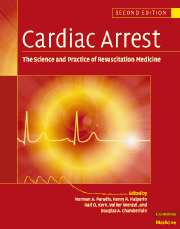Book contents
- Frontmatter
- Contents
- List of contributors
- Foreword
- Preface
- Part I Introduction
- Part II Basic science
- Part III The pathophysiology of global ischemia and reperfusion
- Part IV Therapy of sudden death
- Part V Postresuscitation disease and its care
- 47 Postresuscitation syndrome
- 48 Prevention and therapy of postresuscitation myocardial dysfunction
- 49 Prevention of postresuscitation neurologic dysfunction and injury by the use of therapeutic mild hypothermia
- 50 Postresuscitation neurologic prognostication and declaration of brain death
- 51 Bringing it all together: brain-oriented postresuscitation critical care
- Part VI Special resuscitation circumstances
- Part VII Special issues in resuscitation
- Index
48 - Prevention and therapy of postresuscitation myocardial dysfunction
from Part V - Postresuscitation disease and its care
Published online by Cambridge University Press: 06 January 2010
- Frontmatter
- Contents
- List of contributors
- Foreword
- Preface
- Part I Introduction
- Part II Basic science
- Part III The pathophysiology of global ischemia and reperfusion
- Part IV Therapy of sudden death
- Part V Postresuscitation disease and its care
- 47 Postresuscitation syndrome
- 48 Prevention and therapy of postresuscitation myocardial dysfunction
- 49 Prevention of postresuscitation neurologic dysfunction and injury by the use of therapeutic mild hypothermia
- 50 Postresuscitation neurologic prognostication and declaration of brain death
- 51 Bringing it all together: brain-oriented postresuscitation critical care
- Part VI Special resuscitation circumstances
- Part VII Special issues in resuscitation
- Index
Summary
Introduction
It is estimated that between 400 000 and 460 000 individuals suffer an episode of sudden cardiac arrest every year in the United States. Yet, the percentage of individuals who are successfully resuscitated and leave the hospital alive with intact neurological function averages less than 10% nationwide. Efforts to restore life successfully are formidably challenging. They require not only that cardiac activity be initially restored but that injury to vital organs be prevented or minimized. A closer examination of resuscitation statistics reveals that efficient Emergency Medical Services systems are able to re-establish cardiac activity in 30% to 40% of sudden cardiac arrest victims at the scene. Yet, close to 40% die before admission to a hospital presumably from recurrent cardiac arrest or complications during transport. Of those admitted to the hospital nearly 60% succumb before discharge, such that only one in four initially resuscitated victims leaves the hospital alive.
Although the causes of postresuscitation deaths have not been systematically investigated, the available information suggests that postresuscitation myocardial dysfunction, hypoxic brain damage, systemic inflammatory responses, intercurrent illnesses, or a combination thereof are the main culprits. The core pathogenic process driving such poor outcome is the intense ischemia of variable duration that organs suffer after cessation of blood flow and the subsequent reperfusion injury that accompanies the resuscitation effort. In addition, the precipitating event of cardiac arrest may also play a role in the postresuscitation phase.
- Type
- Chapter
- Information
- Cardiac ArrestThe Science and Practice of Resuscitation Medicine, pp. 829 - 847Publisher: Cambridge University PressPrint publication year: 2007



